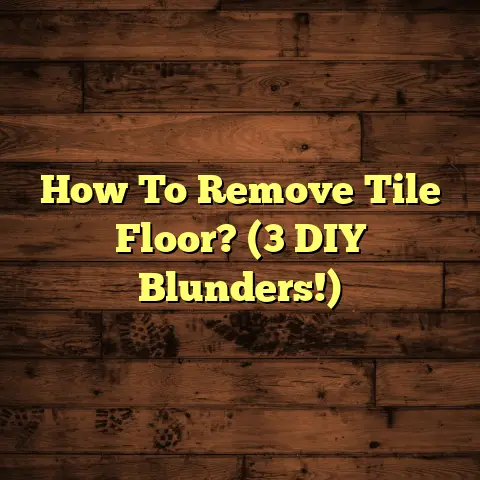Ash Flooring: Good Choice? (3 Common Fails!)
And today, we’re diving deep into the world of ash flooring.
Ash flooring is making waves with its bold designs and striking visual appeal.
Think of it: light, airy tones, unique grain patterns that dance across your floor, and a versatility that fits right into modern, contemporary, and even rustic homes.
It’s no wonder people are drawn to it!
But is it really the perfect choice for your home?
Let’s find out!
The Allure of Ash Flooring
Okay, let’s talk about what makes ash flooring so darn attractive.
First off, it’s a hardwood, which automatically puts it in a different league than softer woods or laminate options.
As a seasoned contractor, I can tell you that durability is key, and ash generally holds up pretty well to everyday wear and tear.
I’ve seen it withstand kids, pets, and even the occasional clumsy adult (no judgment!).
But it’s not just tough; it’s beautiful.
Ash has a distinctive grain pattern – think bold, flowing lines – that adds character and visual interest to any room.
The light color also makes it incredibly versatile.
It can brighten up a dark space or complement a minimalist design.
And let’s not forget about the finish options!
You can stain ash flooring to achieve a wide range of looks, from a warm, honey tone to a cool, contemporary gray.
The possibilities are endless!
Now, I know what you’re thinking: what about the environment?
Well, ash can be a sustainable flooring option, if it’s sourced responsibly.
Look for certifications like the Forest Stewardship Council (FSC) to ensure that the wood comes from sustainably managed forests.
This means that the trees are harvested in a way that protects the environment and supports local communities.
So, ash flooring can be a beautiful and eco-conscious choice.
But before you rush out and buy a truckload of ash planks, let’s talk about the not-so-pretty side of things.
Common Fails of Ash Flooring
Alright, buckle up, because we’re about to get real.
As much as I love the look of ash flooring, I have to be honest: it’s not without its challenges.
Over the years, I’ve seen three common fails pop up time and time again, and I want you to be aware of them before you make a decision.
Fail #1: Color Variability
Okay, let’s talk about color.
Ash is a natural product, and like any natural material, it has variations.
This means that no two ash planks are exactly the same color.
Some planks might be lighter, some might be darker, and some might have more pronounced grain patterns.
Now, for some people, this is part of the charm of ash flooring.
They love the natural, rustic look that the variations create.
But for others, it can be a major headache.
I’ve had clients who were expecting a uniform look, only to be disappointed when their new ash floor looked like a patchwork quilt.
And let me tell you, trying to fix this issue after the floor is installed is a nightmare!
One project I worked on comes to mind.
The homeowners wanted a sleek, modern look, and they chose ash flooring because they loved the light color.
But when the floor was installed, they were shocked by the amount of variation in the planks.
Some planks were almost white, while others had a yellow tint.
It completely clashed with their modern aesthetic.
We ended up having to replace a significant portion of the floor to achieve a more consistent look, which was costly and time- consuming.
I even had one client call me in a panic, claiming their floor looked like it had a “zebra stripe” effect because of the variations!
Now, I wouldn’t go that far, but I understood their frustration.
So, what can you do to avoid this problem?
- Inspect the planks before installation: Before your contractor starts laying the floor, take the time to inspect each plank. If you see any planks that are significantly different in color or grain pattern, set them aside.
- Mix and match: When installing the floor, try to mix and match the planks to create a more balanced look. Don’t put all the light planks in one area and all the dark planks in another.
- Consider a stain: If you’re really concerned about color variation, you might want to consider staining the floor. A stain can help to even out the color and create a more uniform look.
Fail #2: Susceptibility to Water Damage
Alright, let’s talk about water.
Water and wood are not friends.
And unfortunately, ash is particularly vulnerable to water damage.
I’ve seen ash floors warp, buckle, and even rot after being exposed to moisture.
Living in a humid climate or an area prone to spills can be a recipe for disaster.
I remember one client who lived in a coastal town.
They loved the look of ash flooring, but they didn’t realize how humid it was in their area.
Over time, the moisture in the air caused the ash floor to warp and buckle.
The planks started to separate, and the floor became uneven.
It was a costly repair, and they ended up having to replace the entire floor with a more water-resistant material.
Another client had a leaky dishwasher that they didn’t catch right away.
By the time they realized there was a problem, the water had already seeped into the ash floor.
The floor was so damaged that it had to be replaced.
And let me tell you, dealing with mold and mildew in a water-damaged floor is not fun!
A statistic to keep in mind: According to the National Wood Flooring Association (NWFA), excessive moisture is the leading cause of wood flooring problems.
So, what can you do to protect your ash floor from water damage?
- Control the humidity: Use a dehumidifier to keep the humidity in your home at a reasonable level. This is especially important if you live in a humid climate.
- Clean up spills immediately: Don’t let spills sit on your ash floor. Clean them up right away with a soft cloth.
- Use mats and rugs: Place mats and rugs in high-traffic areas, such as entryways and kitchens, to protect the floor from water and dirt.
- Consider a water-resistant finish: There are water-resistant finishes available that can help to protect your ash floor from moisture. Talk to your contractor about your options.
- Be extra careful in bathrooms and kitchens: Ash flooring isn’t the best choice for bathrooms or kitchens, where water is more likely to be present. If you do choose to install ash flooring in these areas, be extra careful to protect it from moisture.
Fail #3: Scratching and Dents
Okay, let’s talk about scratches and dents.
Ash is a relatively soft hardwood, which means it’s more prone to scratching and denting than harder woods like oak or maple.
Now, I’m not saying that ash flooring will fall apart if you look at it the wrong way, but it’s important to be aware of this issue, especially if you have pets or kids.
I’ve seen ash floors get scratched by pets’ claws, dented by dropped objects, and scuffed by furniture legs.
One client had a beautiful ash floor installed in their living room.
They loved the look of it, but they had a large dog who loved to run around and play.
Over time, the dog’s claws scratched the ash floor.
The scratches weren’t deep, but they were noticeable, and they detracted from the overall look of the floor.
Another client dropped a heavy vase on their ash floor.
The vase left a significant dent in the floor, which was impossible to repair without replacing the plank.
I even had one client complain that their ash floor was getting scratched just from people walking on it!
Now, I think that’s a bit of an exaggeration, but it does illustrate the point that ash flooring is more susceptible to scratching and denting than other types of flooring.
According to the Janka hardness scale, which measures the relative hardness of wood species, ash has a rating of around 1320.
Oak, on the other hand, has a rating of around 1290.
While this may not seem like a huge difference, it can make a difference in terms of scratching and denting.
So, what can you do to protect your ash floor from scratches and dents?
- Use rugs and mats: Place rugs and mats in high-traffic areas to protect the floor from scratches and dents.
- Trim your pets’ nails: Keep your pets’ nails trimmed to minimize scratching.
- Use furniture pads: Place furniture pads under the legs of your furniture to prevent scratching and denting.
- Avoid wearing shoes indoors: Encourage people to take off their shoes when they come inside to avoid tracking in dirt and debris that can scratch the floor.
- Be careful when moving furniture: When moving furniture, lift it instead of dragging it to avoid scratching the floor.
Conclusion
So, is ash flooring a good choice?
Well, it depends.
It’s undeniably beautiful, with its light color, unique grain patterns, and versatility.
It can add a touch of elegance and sophistication to any home.
But it’s also important to be aware of the potential pitfalls.
Color variability, susceptibility to water damage, and scratching and denting are all issues that you need to consider before making a decision.
If you’re willing to take the necessary precautions and maintain the floor properly, ash flooring can be a great choice.
But if you’re looking for a low-maintenance, bulletproof flooring option, you might want to consider something else.
Ultimately, the decision is up to you.
Weigh the pros and cons, consider your lifestyle and your environment, and choose the flooring that’s right for you.
And if you’re still not sure, don’t hesitate to consult with a flooring professional.
I’m always happy to help!





